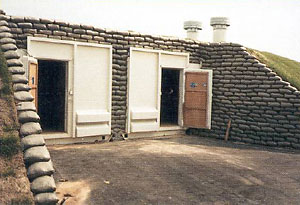What's in This Document
 |
Tables of Distances
The Federal explosives regulations, as prescribed in 27 CFR § 555.206, require explosives storage magazines to be located certain minimum distances from inhabited buildings, highways, passenger railways, and other magazines based on the quantity of explosive materials in each magazine. These tables of distances are designed to protect the public in the event of a magazine explosion.
- The tables of distances generally apply to the outdoor storage of explosive materials.
- When determining the distance from a magazine to a highway or an inhabited building, an individual must measure from the nearest edge of the magazine to the nearest edge of the highway or inhabited building.
- If any two or more magazines are separated by less than the specified distance, then the weights in the magazines must be combined and considered as one.
- Explosive materials not subject to the activities in 27 CFR § 555.205 must be stored in a magazine that meets the table(s) of distances based on the class or type of explosive material.
- 27 CFR § 555.218 – Storage of high explosives, blasting agents, bulk salutes and more than 10,000 pounds of display fireworks.
- 27 CFR § 555.219 – Storage of low explosives.
- 27 CFR § 555.220 – Storage of high explosives and blasting agents from ammonium nitrate and blasting agents.
- 27 CFR § 555.224 – Storage of 10,000 pounds or less of display fireworks (except bulk salutes).
- The storage of blasting agents and ammonium nitrate, when located in the proximity of high explosives or other blasting agents, is subject to the distance limitations prescribed in the tables of distances at 27 CFR 555.218 and 555.220. Click here for guidance on how to apply these tables.
A single magazine (or group of magazines considered as one for table of distance purposes) cannot contain more than 300,000 pounds of explosive materials or more than 20 million detonators. Federal explosives licensees and permittees can submit variance requests to exceed these amounts provided the conditions in 27 CFR § 555.22 are met. Click here for more information on how to request a variance.
ATF Table of Distance-Related Rulings
ATF Ruling 75-20: Clarifies that offices or repair shops used in connection with the manufacture, transportation, storage, or use of explosive materials are not inhabited buildings.
ATF Ruling 2005-2: Provides guidance on private roads subject to the tables of distances.
ATF Ruling 2005-3: Provides guidance on inhabited buildings subject to the tables of distances.
Barricades
Under certain tables of distances, barricades can reduce the minimum required distance from exposed sites, such as inhabited buildings. Barricading is the effective screening of a magazine containing explosive materials from another magazine, an inhabited building, a passenger railway, or a highway, either by a natural barricade or by an artificial barricade.
Natural barricades, as defined in 27 CFR § 555.11, are “Natural features of the ground, such as hills, or timber of sufficient density that the surrounding exposures which require protection cannot be seen from the magazine when the trees are bare of leaves.”
An artificial barricade, as defined in 27 CFR § 555.11, is “An artificial mound or revetted wall of earth of a minimum thickness of three feet, or any other approved barricade that offers equivalent protection.”
To be properly barricaded, a straight line from the top of any sidewall of the magazine containing explosive materials to the eave line of any other magazine or building, or to a point 12 feet above the center of a railway or highway, will pass through the natural or artificial barricade.


